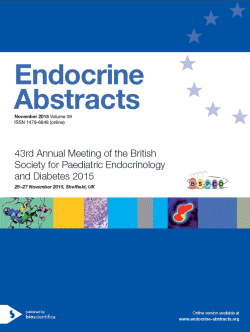
43rd Meeting of the British Society for Paediatric Endocrinology and Diabetes
ORAL COMMUNICATIONS
Oral Communications 7
ea0039oc7.1 | Oral Communications 7 | BSPED2015
Wolfram syndrome: natural history and genotype-phenotype correlation based on EURO-WABB registry show gender differences in disease severity
Dias Renuka , Richens Caitlin , Astuti Dewi , Nightingale Peter , Ayme Segolene , Lopez de Heredia Miguel , Maffei Pietro , McCafferty Susan , Mlynarski Wojciech , Nunes Virginia , Parkinson Kay , Paquis-Flucklinge Veronique , Rohayem Julia , Sinnott Richard , Tillmann Vallo , Tranebjaerg Lisbeth , Barrett Timothy
ea0039oc7.2 | Oral Communications 7 | BSPED2015
Insulin and glucose profiles following an oral glucose tolerance test in patients with cystic fibrosis and classification tree modelling of insulin:glucose profiles as a tool to predict changes in lung function
Nicholson Simon , Aldag Ina , West Noreen , Wright Neil
ea0039oc7.3 | Oral Communications 7 | BSPED2015
Safety and efficacy of atorvastatin treatment in children with familial hypercholesterolaemia
ea0039oc7.4 | Oral Communications 7 | BSPED2015
The cost-effectiveness of the KIds in control of food structured education programme for adolescents with type 1 diabetes
Basirir Hasan , Brennan Alan , Jacques Richard , Pollard Daniel , Stevens Katherine , Freeman Jennifer , Wales Jeremy , Price Katherine
ea0039oc7.5 | Oral Communications 7 | BSPED2015
Investigating the impact of post-translational modification of Type 1 diabetes auto-antigens by tissue transglutaminase.
Donnelly Catherine , Williams Alistair
ea0039oc7.6 | Oral Communications 7 | BSPED2015
The evolving phenotype of transient neonatal diabetes 1: findings from the international register
Lokulo-Sodipe Kemi , James Rowena S , Zalkapli N N , Docherty Louise E , Davies Justin H , Mackay Deborah J G , Temple I Karen



